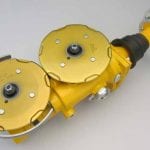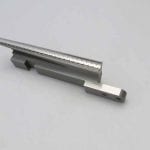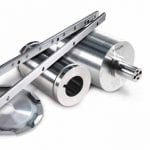Smart supply chain solutions facilitate the procurement and storage of spare parts.
By Stefanie Rossel
In a previous report on tobacco equipment consumables (see “The real stuff,” October 2014), Tobacco Reporter found that parts are as important to cigarette machinery as capsules are to modern coffee makers. High-quality, properly fitting parts ensure smooth operation and consistent product quality for tobacco producers and coffee connoisseurs alike. Low-quality, improperly fitting parts, by contrast, are likely to create problems. Any savings on the initial purchase price are likely to be wiped out by reduced efficiency, compromised product quality and shortened machinery lifespans.
As the tobacco industry navigates fundamental market changes, perhaps it’s appropriate to develop this analogy a little further: Imagine that, in addition to offering a vast array of flavors, your favorite coffee vendor would also know when your ristretto is running low. Instead of requiring you to order and stock large volumes, your suppliers would automatically send to you the next batch of coffee—exactly the desired amount and just in time. And this, more or less, is how the supply of spare and wear parts, in its most advanced form, works nowadays.
While optimizing efficiency has always been a main objective in cigarette production, the speed of such efforts has accelerated in recent years, after leading tobacco manufacturers, in light of falling cigarette sales, began closing factories and centralizing production.
As a consequence, a lot of relatively new machinery has become available, stifling demand for new equipment. Spare and wear parts have been “set free” as well. For the manufacturers of such consumables, however, the cigarette companies’ moves have turned out to be less negative than might have been expected.
“The movement of production undoubtedly has an effect on suppliers, as the transition periods can be lengthy and factories seek to run stocks down before relocating,” says Paul Farrell, spares manager at Molins Tobacco Machinery. “We have found that as machinery has ‘cascaded’ it is an opportunity for Molins, as older machinery is brought out of storage and requires spares and overhaul projects. The market is still very nervous about committing to new equipment, however; this has worked in favor of our spares business in the short term.”
“There is a short impact due to the consolidation of spare parts from other factories,” says Russell Greenwood, spares operations manager at Garbuio Dickinson, which specializes in primary department (PMD) equipment and was acquired by Hauni Maschinenbau in 2014. “This impact is small on PMD equipment, as the level of spares held in stock is minimal.”
Farrell goes on to explain that, with the tobacco business depressed, his company had lowered its outlook for the spare parts business correspondingly. “However, we have found that for spare parts and additional equipment the market has been very positive,” he says. “Customers who were previously running down inventories now have requirements, and machinery that would previously have been put into storage is still running.”

Like Garbuio Dickinson, ITM has experienced stable regular spare parts sales. “At ITM Poland we have even seen a boost in the start-up and consumable spares due to the sales of recently launched equipment,” says Henk Meijer, manager of services at ITM.
The better-than-expected sales are not due to good fortune alone; they are also a result of hard work. “We have worked hard with our customer base to keep the appropriate level of consumable parts in stock constantly and have excellent freight links globally,” says Farrell.
Meijer points out that all multinational cigarette manufacturers have introduced cost-reduction schemes. “This is also affecting the spare parts business,” he says. “The targets set for spares prices are putting pressure on the margins, and we nowadays have to go through various rounds of negotiations before new spares contracts can be signed.”
In order to remain competitive, spare parts suppliers must take fresh approaches, says Heiko Geissler, head of service operations at Hauni. With worldwide cigarette production stagnating, he believes the demand for spare parts will stay the same. “Growth can only be generated through new products or added value in the after-sales service,” says Geissler. As an example, he points to the integration of the Decoufle spare parts business into Hauni’s Hamburg operations. “Through this, our customers get some added value as far as performance is concerned,” says Geissler. “In addition, purchasing processes have been facilitated.”
Growing complexity

Supplying spare and wear parts to the tobacco industry has become an increasingly complex business, holding ever-new challenges for suppliers. Geissler says Hauni has used the past 18 months to develop, among other things, a technology that automatically creates certificates of origins for its spares. “This tool will accelerate customs procedures by up to four days,” he says. In addition to having a good understanding of the world’s increasingly complex customs regulations, today’s spare and wear parts suppliers must be aware of the interaction between many independent products and comprehend the interlaced, intelligent supply chain, according to Geissler.
Meijer observes that, in addition to seeking state-of-the-art parts at the best possible price, clients now also demand obsolescence management. They emphasize issues such as sustainability, recycling and power consumption, which places new demands on equipment manufacturers. “This will have its impact in the long term,” he says.
After a round of spare part redistribution to accommodate reduced manufacturing footprints, Meijer expects tobacco companies to introduce “meaner and leaner” procurement procedures. “This requires a new approach in the way client and supplier are managing the spare parts supply lines,” he says.
To comply with cigarette manufacturers’ mentioned requirements, as well as demand for shorter lead times, longer-lasting parts and reduced stocks, additional efforts are required from parts suppliers, according to Meijer.
“This often means tailor-made solutions that can only be achieved in partnership with the client; therefore we have to move away from the traditional client-customer relationship,” he says. “In order to come to sensible and sound solutions, all aspects of the aftersales business should be taken into account.”
VMI rising
Supply chain optimization—particularly inventory management—has increasingly become the focus of suppliers’ efforts. The companies interviewed for this article provide various digital solutions that allow their customers to check availability of spares, obtain online quotations and place orders. All of them have implemented vendor-managed inventory (VMI) systems.
Garbuio Dickinson uses a customer-relationship management (CRM) tool to help predict demand based on a combination of history, machinery in operation and machinery likely to continue to be in operation.
“Customers are rightfully seeking to push back inventory holding onto suppliers and request ever-decreasing lead times,” says Farrell of Molins. “We did a large-scale exercise scrutinizing our supply chain, determining what inventory needs to be held in stock, pushing inventory vertically down the supply chain and providing more supply options,” he says. “This has led to Molins being able to reduce the lead times for proprietary parts by an average of 42 percent. We are also happy to work with customers’ needs and hold stock of key items for call-off orders.”
According to Farrell, spares demand levels vary rapidly and Molins’ systems are constantly monitoring and adjusting stock levels to ensure the perfect balance, maintaining the highest percentage of in-stock availability. “Our machinery design team always considers the reduction of parts count and use of common parts for various machine groups, which in turn reduces our and our customers’ stock level requirements,” he says.
Molins experience with VMI has been positive. “We frequently receive requests from customers to provide recommended essential spares lists for their machinery; we then provide the customer with an update on what we recommend they purchase now and in the future,” says Farrell. “This has to be a two-way process to work, as our estimations on consumption come from the customer providing us with production information; however, this helps to foster trust and understanding within our relationships.”
One of the challenges in implementing such an advanced management tool, notes Meijer, is that its success depends largely on the sophistication of clients’ IT systems and customers’ ability to predict their parts requirements. VMI has been an option in recent ITM projects, and the company can offer it as part of a service package. “Such a package is part of an agreed after-sales service contract with a mutually agreed scope and fee,” says Meijer.
The latest generation of tobacco machinery features smart sensors to accurately predict when parts must be replaced, according to Geissler. “Combined with the remote service Hauni offers, technicians at our site in Hamburg-Bergedorf can directly access the machine, make recommendations and intervene if necessary,” he says. “Supported by our intelligent-supply concepts, the required spare part can be sent out immediately.”
He adds that, in addition to Hauni’s web shop and electronic data-interchange (EDI) system, VMI has established itself as an independent e-commerce service. “Our VMI services continue to be in high demand,” says Geissler. “We now have connected around 50 customers with this tool. While clients were skeptical in the beginning, they are now increasingly willing to shift responsibility for their materials supply to the supplier. This readiness is the basis for talks about further developments because an active management of customers’ inventories leaves ample scope with many chances for the client. The integration of Decoufle’s spare parts provides us with the potential to expand our VMI offer for existing and new customers.”
Carefree sourcing
“Challenges to deliver a high-quality product with ever-decreasing resources relies on reliable and effective operations not only from individual assets but [also from] all the processes that make up a manufacturing unit,” says Alex Cormack, operations director at Gemba Solutions, a U.K.-based IT solutions provider specializing, among other things, in overall equipment effectiveness. Many manufacturers now run a mixture of OEM and older equipment—a situation that, according to Cormack, can affect reliability and failure rates, impacting the manufacturer’s return on investment.
To optimize performance even in a mixed-equipment scenario, ITM uses Gemba Solutions’ production-efficiency software and services. Taking a holistic view, ITM is able to monitor not just its own equipment but any machine or process in the production process. This ability enables the company to pinpoint failures in real time and manage capacity improvement activity while maintaining output levels from older equipment.
“Excellent support and spares strategies can reduce the impact of older equipment failure, though the frequency and modes may become more difficult to manage when assets age beyond their predicted reliable years,” says Meijer. “This old equipment may not employ the latest condition-based monitoring systems. The introduction of modern manufacturing techniques is increasingly becoming a must-have culture within the cigarette industry. The basis of Lean, Agile and Six Sigma methods are all reliant on the ease of collection and analysis of good data; the ITM Gemba system and support helps drive these seamlessly.”
Hauni also offers a comprehensive spare parts supply chain-management solution. The company provides spare parts from more than 1,100 suppliers. Its system offers customers more than 400,000 items 24/7, 365 days a year.

Based on forecasting methods, Hauni can take over its customers’ spare parts planning. The company independently defines the optimal inventory level of each spare that needs to be in stock at the customer’s site. “To achieve this, we file each spare part in different clusters, based on its history of consumption,” explains Claus Peters, group manager of services at Hauni. “Dependent on this, we determine the desired scope of supply together with our customer in an initial provisioning study. We then agree [on] a service level. The service level is aligned to the availability of the agreed range of spare parts. In combination with the spares permanently available ex-Hauni and the articles stored at the customer’s site, it stands at 99.5 percent.”
As soon as the initial provisioning study has been finalized, the scope of supply is being mapped onto Hauni’s forecast and planning tools. The company then takes on the materials planning of the agreed array of spare parts. The cluster assignment of the individual parts with regard to ongoing consumption is checked regularly and adapted if necessary. “The customer profits in many ways from this solution,” says Peters. “By means of tailor-made logistics concepts it significantly improves the availability of materials and ad hoc supply; through optimized stock levels it enhances capital lockup. In addition, it considerably reduces the complexity of customers’ procure processes and brings about operational relief, thus creating more room for clients to focus on their core business.”



















